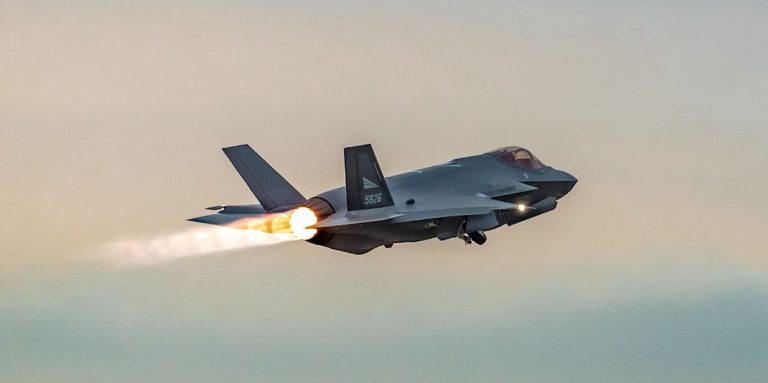
F-35 Fighter Jets From Netherlands and Norway Will Protect Ukraine Supply Lines from Possible Russian Attack
New York, N.Y. – In a significant escalation of NATO’s defensive posture along Europe’s eastern frontier, Dutch and Norwegian F-35 fighter jets will establish a combined operational presence in Poland under direct NATO command, marking a crucial step in protecting vital supply corridors to Ukraine while maintaining robust air defense capabilities across the region.
The Netherlands Ministry of Defense announced Monday that Dutch F-35s will deploy to Poland from September through December 2024, responding to a formal request from NATO’s Supreme Headquarters Allied Powers Europe (SHAPE). This deployment represents a strategic commitment to safeguarding military aid shipments destined for Ukraine while strengthening NATO’s collective defense architecture.
Strategic Imperative Drives F-35 Deployment
“It is essential that we contribute to the defense of NATO territory and the security of Europe,” declared Dutch Minister of Defense Ruben Brekelmans in the official statement. “We are once again doing so with our most advanced capabilities.”
The deployment directly addresses growing concerns over Russian interference with military supply lines supporting Ukraine’s defense efforts. By establishing a persistent aerial presence over Eastern Europe, the F-35s will create a protective umbrella ensuring that critical military equipment reaches its intended destination without interruption.
Brekelmans emphasized the deterrent effect of the deployment, stating, “In this way, we are literally keeping the Russian threat at bay.” The minister cited recent successes in Estonia, where Dutch F-35s demonstrated exceptional effectiveness in air-policing operations at Ämari Air Base since December 2023.
Multinational Cooperation Enhances Defense Capabilities
The Polish deployment will operate as a combined Dutch-Norwegian detachment, with both nations sharing personnel and material resources to maximize operational efficiency. This collaborative approach exemplifies NATO’s commitment to burden-sharing while leveraging each nation’s specialized capabilities.
Operating under a quick-reaction alert posture, the F-35s will maintain 24-hour readiness, ensuring immediate response to potential airspace violations or imminent threats to NATO territory. The transfer of authority to direct NATO command demonstrates the alliance’s unified approach to regional security challenges.
Protecting Critical Supply Infrastructure
The deployment serves multiple strategic objectives beyond traditional air defense. Military equipment donated by NATO countries to Ukraine must traverse vulnerable supply routes, making protection of these corridors essential for sustained support operations. The F-35s will provide overwatch for ground-based logistics activities, ensuring safe passage of military aid while deterring potential interference.
Brekelmans highlighted this critical mission in correspondence to Dutch parliament, noting that contributing to Poland’s air defense capabilities enables the alliance to “safely carry out ground-based activities in support of the Ukrainian war effort.”
Advanced Capabilities Meet Modern Threats
The F-35 Lightning II represents the pinnacle of modern fighter aircraft technology, combining stealth capabilities, advanced sensors, and network-centric warfare systems. These fifth-generation fighters provide NATO with unprecedented situational awareness and response capabilities across the electromagnetic spectrum.
The aircraft’s advanced radar systems can detect and track multiple threats simultaneously while maintaining low observability, making them ideal for both defensive and deterrent operations. Their ability to share real-time intelligence with other NATO assets creates a comprehensive defensive network spanning the alliance’s eastern boundaries.
Historical Context and Regional Implications
This deployment builds upon NATO’s Enhanced Forward Presence initiatives, which have strengthened alliance capabilities across the Baltic states and Poland since 2016. The stationing of F-35s in Poland represents a qualitative enhancement to these existing defense arrangements, providing cutting-edge aerial capabilities previously unavailable in the region.
The timing coincides with heightened tensions along NATO’s eastern frontier, where Russian military activities have increased pressure on alliance members. By demonstrating resolve through deployment of premier military assets, NATO reinforces its commitment to collective defense principles enshrined in Article 5 of the Washington Treaty.
Future Implications for Alliance Defense
The Dutch-Norwegian deployment establishes a precedent for multinational F-35 operations under NATO command, potentially serving as a model for future alliance initiatives. As more NATO members acquire F-35 aircraft, similar collaborative deployments could become standard practice for addressing regional security challenges.
This development also underscores the evolving nature of NATO’s mission, adapting traditional collective defense concepts to address contemporary security challenges including hybrid warfare, supply line protection, and deterrence operations short of armed conflict.
The successful integration of Dutch and Norwegian F-35s under unified command structure demonstrates NATO’s operational flexibility and commitment to leveraging advanced capabilities for collective security objectives across the European theater.
Summary
The deployment of Dutch and Norwegian F-35s to Poland under NATO command represents a significant enhancement to alliance air defense capabilities. Operating from September through December, these advanced fighter jets will protect critical supply lines to Ukraine while maintaining 24-hour readiness to respond to potential airspace violations. This multinational effort demonstrates NATO’s commitment to collective defense and burden-sharing while adapting to evolving security challenges along Europe’s eastern frontier.